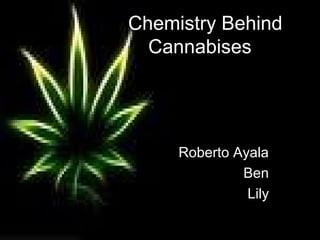
Chemistry behind cannabises
- 1. Chemistry Behind Cannabises Roberto Ayala Ben Lily
- 2. What is inside Cannabis • The chemistry behind cannabis is really complex. There are over 400 different chemicals in cannabis. The main component responsible for the mind-altering effects is Delta-9- tetrahydrocannabiol (THC). From the 400 different Chemicals in cannabis but only 60 of them are unique to cannabis.
- 3. How does THC work Inside the human body. • Neurotransmitters fill the gap, or synapse, between two neurons and bind to protein receptors, which enable various functions and allow the brain and body to be turned on and off. Foreign chemicals, like THC, can mimic or block actions of neurotransmitters and interfere with normal functions.
- 4. Names Not common • cannabinol (CBN), cannabichromene (CBC), cannabigerol (CBG), and tetrahydrocannabivarin (THCV). More common • (27 known), amino acids (18), proteins (3), glycoproteins (6), enzymes (2), sugars and related compounds (34), hydrocarbons (50), simple alcohols (7), aldehydes (13), ketones (13), simple acids (21), fatty acids (22), simple esters (12), lactones (1), steroids (11), terpenes (120), non-cannabinoid phenols (25), flavonoids (21), vitamins (1) [Vitamin A], pigments (2), and elements (9)
- 5. Pictures
- 6. Cannabis Bibliography • http:// www.emcdda.europa.eu /publications/drug-profiles/can • http://medicalmarijuana.pr ocon.org/view.answers.ph p?questionID=000636 • http://www.weedist.com/2 012/07/tailoring-high- compounds-in-cannabis- properties-boiling-points/
- 7. Cont… • http://www.drugscie nce.org/Petition/C8 C.html • http://science.howst uffworks.com/mariju ana3.htm